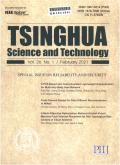A GNSS Anti-Spoofing Technique Based on the Spatial Distribution Characteristic of the Residual Vectors
IF 3.5
1区 计算机科学
Q1 COMPUTER SCIENCE, INFORMATION SYSTEMS
引用次数: 0
Abstract
Anti-spoofing is becoming a crucial technique for applications with high navigation accuracy and reliability requirements. Anti-spoofing technique based on Receiver Autonomous Integrity Monitoring (RAIM) is a good choice for most Global Navigation Satellite System (GNSS) receivers because it does not require any change to the hardware of the receiver. However, the conventional RAIM method can only detect and mitigate a single spoofing signal. Some improved RAIM methods can deal with more spoofing signals, but the computational complexity increases dramatically when the number of satellites in view increase or need additional information. This paper proposes a new RAIM method, called the SRV-RAIM method, which has a very low computation complexity regardless of the number of satellites in view and can deal with any number of spoofing signals. The key to the new method is the spatial distribution characteristic of the Satellites' Residual Vectors (SRV). In replay or generative spoofing scenarios, the pseudorange measurements of spoofing signals are consistent, the residual vectors of real satellites and those of spoofing satellites have good separation characteristics in spatial distribution. Based on this characteristic, the SRV-RAIM method is proposed, and the simulation results show that the method can separate the real signals and the spoofing signals with an average probability of 86.55% in the case of 12 visible satellites, regardless of the number of spoofing signals. Compared to the conventional traversal-RAIM method, the performance is only reduced by 3.59%, but the computational cost is reduced by 98.3%, so most of the GNSS receivers can run the SRV-RAIM algorithm in time.基于残差矢量空间分布特性的GNSS反欺骗技术
对于具有高导航精度和可靠性要求的应用来说,反欺骗正成为一项关键技术。基于接收机自主完整性监测(RAIM)的反欺骗技术是大多数全球导航卫星系统(GNSS)接收机的良好选择,因为它不需要对接收机的硬件进行任何更改。然而,传统的RAIM方法只能检测和减轻单个欺骗信号。一些改进的RAIM方法可以处理更多的欺骗信号,但当视野中的卫星数量增加或需要额外信息时,计算复杂度会急剧增加。本文提出了一种新的RAIM方法,称为SRV-RAIM方法。无论视野中的卫星数量如何,该方法的计算复杂度都很低,并且可以处理任何数量的欺骗信号。新方法的关键是卫星残差矢量(SRV)的空间分布特性。在重放或生成欺骗场景中,欺骗信号的伪距测量是一致的,真实卫星和欺骗卫星的残差向量在空间分布上具有良好的分离特性。基于这一特点,提出了SRV-RAIM方法,仿真结果表明,在12颗可见卫星的情况下,无论欺骗信号的数量如何,该方法都可以将真实信号和欺骗信号分离,平均概率为86.55%。与传统的遍历RAIM方法相比,性能仅降低了3.59%,但计算成本降低了98.3%,因此大多数GNSS接收器都可以及时运行SRV-RAIM算法。
本文章由计算机程序翻译,如有差异,请以英文原文为准。
求助全文
约1分钟内获得全文
求助全文

 求助内容:
求助内容: 应助结果提醒方式:
应助结果提醒方式:


